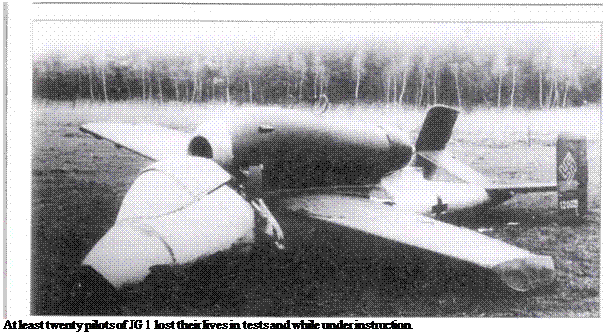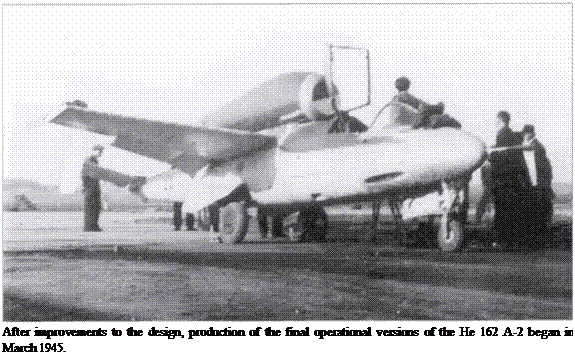Production Gears Up
The manufacture of fuselages, wings and tailplanes began simultaneously. At the beginning of November 1944 the first frames for the He 162 V-l forward fuselage were on the belt at Languste. The first wing hurriedly completed at Franken was faulty. The tail and components were to be rushed out and delivered from Lower Austria. On 7 December assembly of He 162 V-2 started. Delays in the supplies of tailplanes and wings held back the construction of further prototypes.
On 6 December 1944 Engineer Gotthold Peter, leading test pilot at Heinkel – Siid, flew the He 162 V-l (M-l) for the first time. The second test, an exhibition flight for General Commissioner Kessler and Chief-TLR Oberst Diesing, ended in disaster. Due to defective bonding the starboard wing leading edge was

ripped away. The aircraft immediately started rolling, the starboard aileron and wingtip then broke off at 735 km/hr (455 mph) damaging the tailplane and causing the machine to spin out of control and crash just beyond the perimeter of the airfield at Fischamend. The pilot was killed. An immediate enquiry was ordered. An air safety commission investigated and made its recommendations within a few days. He 162 V-3 was subjected immediately to vibration testing to ensure the integrity of the structure. Consideration was given to replacing the wood surfaces with metal.
The next completed prototype was gone over with a fine-tooth comb. As a result, in mid-December the He 162 was grounded for nine defects. Between 16 and 20 December a commission was set up by the Chief-TLR to examine the structural integrity and flight safety of the design. On 22 December director Karl Franke gave the He 162 V-2 a clean bill of health for its maiden flight, and staff engineer Paul Bader flew the aircraft at 500 km/hr (310 mph). He found the rudder and ailerons too weak and criticised the engine, but was otherwise satisfied. By 15 January, pilots Schuck and Kennitz had been trained to fly the Volksjager and made further flights. He 162 M-3 was listed for electronics testing and flew at Heinkel-Siid on 16 January. By the 22nd of the month the machine had completed 13 flights totaling 80 minutes duration. The design was revised to strengthen the wings and tailplane by the end of December, He 162 M-4 being the first of the improved machines. After the Heidfeld controllers examined the fuselage on 28 December, they discovered fifty different defects,
and the maiden flight was therefore delayed until 16 January. Ten flights totalling almost three hours were made in the month. A minor crash occurred on one landing. On 22 January He 162 M-6 and the first pre-series machine, He 162 A-01, were scheduled for pilot training. Next day Pawolka, Bader, Franke, Schuck and Wedemeyer flew the sixth prototype. It was noted that suspension was unnecessary for the nose-wheel and this was eliminated in the series production.
On 4 February He 162 M-6 crashed, killing Oberleutnant Wedemeyer. He 162 M-7 was fitted with a braking parachute as a safety measure for highspeed flights. He 162 M-3, M-4 and the first A-0 were tested in flight for stability in the vertical axis, the Dutch roll moment and the effect of various tailplane combinations.
By 30 January M-2 to M-7 and the first three pre-series aircraft were clear for testing. When this was suspended at the beginning of February because of persistent ground mist, the time was used to repair the damaged nose-wheel of M-6 and exchange the A-02 tail flaps. M-7 was ‘shaken after the braking parachute was fitted and given the all-clear for testing. By 5 March the prototypes had made 63 starts totaling 10 hours 57 minutes: 15 pilots had flown the He 162, some of them only В-2 licence holders and thus relatively inexperienced with high-performance machines.
Shordy afterwards engineer Full achieved a speed of 800 km/hr (Mach 0.65) at 8,000 metres (500 mph at 26,000 ft). Following heavy vibrations the turbine stopped and Full was slightly injured while making a forced landing in snowy terrain. In order to improve stability, the fuselage was lengthened and the dihedral of the wing tip curves lessened. It was decided that an enlarged rudder and modified tailplane were needed. Once the main weaknesses of the aircraft had been identified, from 15 February all existing models underwent modification. The first, He 162 M-3, was flown by Full in mid-February at 880 km/hr (550 mph), the prototype proving fully stable. At the end of February the wing angle was raised by 2 degrees and the fiiselage/wing joint adjusted. In his last flight, Full used the ejector seat to bale out from He 162 M-3 after the turbine caught fire. At 200 metres (650 ft) he was too low for his parachute to deploy in time.
Tests continued and by 25 February Heinkel-Siid had made 166 flights totaling 40.5 hours. The fuel situation was deteriorating almost daily and this, combined with the frequent air raid warnings, held back the tempo of Volksjager development considerably. After He 162 M-25, one of the machines with lengthened fuselage, received 60 per cent damage during a flight on 2 March, works pilot Denzin also lightly damaged another machine. By 11 March the number of He 162 flights had risen to 211 (51 hours 13 minutes). Next day Feldwebel Wanke’s He 162 M-8 hit the runway too early, overturned and caught fire. The pilot survived, injured and badly burned. On 14 March the He 162 of
Unteroffizier Daus of Auffangsstaffel Heidfeld 2./JG 1 collided with barrels near the runway and was killed. He was one of at least 18 He 162 pilots to lose his life in accidents with the aircraft.
The last Heinkel-Siid weekly report is dated 26 March 1945. By then there had been 259 Volksjager flights at Heidfeld alone, totalling 65 hours. Continual modifications in the preceding months had kept most machines grounded. Once the improvements were completed, the last involving the fuel installation, the He 162 was declared operational at the beginning of April 1945.

By now Soviet units were approaching Vienna. To pull back west of the city, or better still into southern Germany or the Harz seemed advisable. On 30 March director Franke went to Saur’s office to plead for a transfer to Bad Gandersheim. This was granted and on 1 April a special train set off for the Harz. After being held three whole days at Eger, the train was re-routed to Jenbach in the Tyrol, arriving there on the night of 5 April. A few hours before, Modling and the underground facility at Languste had been occupied by the Soviets: one day later Schwechat district and the Heidfeld airfield also fell into their hands. The works management had begun to remove some of the instructional documents and installations for the He 162 A-2 to Heinkel Jenbach while the staff went to Lent near Salzburg. The design office was eventually relocated from Jenbach/Tyrol to Landsberg/Lech, arriving there on 14 April,
thirteen days before American forces did so, and thus brought the Volksjager development to its end.










